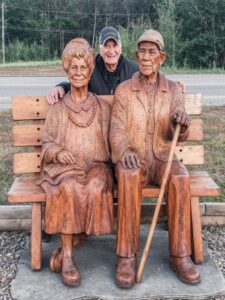This man created his mother and father statue by wood for 3 year
Once upon a time, in a small, quiet village nestled between rolling hills and dense forests, there lived a young man named Arjun. He wasn’t known for grand speeches or feats of physical prowess, but rather for something that would leave a lasting impression on anyone who came to know him: his extraordinary gift with wood.
Arjun had been raised in a humble home by his loving parents, Mira and Prakash. His father worked as a carpenter, shaping beautiful pieces of furniture with the same delicate care that he showed in raising Arjun, and his mother was a weaver, creating colorful, intricate fabrics that adorned their home like pieces of art. The two had always been pillars of strength and love for Arjun, and their unwavering devotion inspired him every day.
One day, when Arjun was in his mid-twenties, tragedy struck the village. His beloved father, Prakash, fell ill, and despite all efforts to heal him, he passed away quietly in his sleep. The loss shattered Arjun and his mother, leaving a void in their hearts that felt impossible to fill. Mira, though devastated, carried on, but Arjun could sense her sorrow every day. She was strong, but even the strongest hearts break when faced with the absence of a loved one.
It was during this time of grief that Arjun, in a quiet moment of reflection, decided he would honor both his parents in a way that would ensure their spirits would never fade from his life. Inspired by the love his parents had shown him, he began an ambitious project — he would carve statues of his mother and father, not out of marble or stone, but from the very wood that his father had worked with all his life.

Arjun started with a small block of wood, but quickly realized that this project would require more than just skill — it would require time, patience, and heart. He spent countless hours in his workshop, chiseling and carving with precision. Day after day, he would shape the wood, bringing to life the likeness of his father, Prakash, with every stroke of his chisel. The features were so finely done that Arjun could almost hear his father’s deep voice and feel the warmth of his embrace in the figures.
But it didn’t stop there. Arjun knew that for his tribute to be complete, he needed to carve his mother, Mira, as well. Her face, so full of kindness and strength, seemed harder to capture in the grain of the wood. For months, he would sit beside the carved figure of his father, working late into the night, shaping her gentle smile, the softness of her eyes, the elegance in the way she carried herself. Slowly, but surely, the figures began to take form — two statues that, though made of wood, seemed to possess the essence of the people he loved most.
As the years passed, Arjun poured his heart and soul into his work. The statues were not simply representations of his parents; they were manifestations of everything they had been: the quiet strength of his father, the nurturing warmth of his mother, and the deep, unbreakable bond they had shared as a family. Each day, as he worked on the statues, Arjun could almost feel them with him again, guiding his hands, whispering their wisdom in the soft creaks of the wood.
After three long years, Arjun finally completed his masterpiece. The statues stood side by side — a tribute to the parents who had given him everything. Their faces were full of life and love, frozen forever in the grain of the wood. It was as though, by capturing them in such a way, he had ensured that their presence would never fade, that they would always be with him.
When Arjun finally revealed his work to the village, everyone was astounded. The statues were unlike anything they had ever seen. People marveled at the intricate details, the lifelike expressions, and the sheer emotion that seemed to emanate from the wood. Some even said that they could feel the warmth of Prakash’s smile or the comfort of Mira’s gaze.
Arjun’s tribute was not just a work of art; it was a testament to love, to grief, and to the power of memory. His mother, when she first saw the statues, wept tears of both sorrow and joy. She saw her husband and her son in those figures, and for the first time in years, she felt whole again.
The statues became a symbol in the village, not only of Arjun’s incredible talent but also of the enduring love that transcends time and space. People would come from far and wide to see the wooden figures, and Arjun’s name spread across the land, not as the son who had lost his parents, but as the artist who had immortalized them.
And so, Arjun’s work lived on, not just in the wood, but in the hearts of all who saw it. His devotion to his parents was a reminder that love, when given freely and wholly, never truly fades. It is carved into the fabric of who we are — as lasting as the wood, as enduring as the memories that shape us.
In the end, Arjun’s masterpiece was more than just a statue. It was a symbol of eternal love, created not with stone, but with the hands and heart of a son who would never forget the parents who had given him everything.


